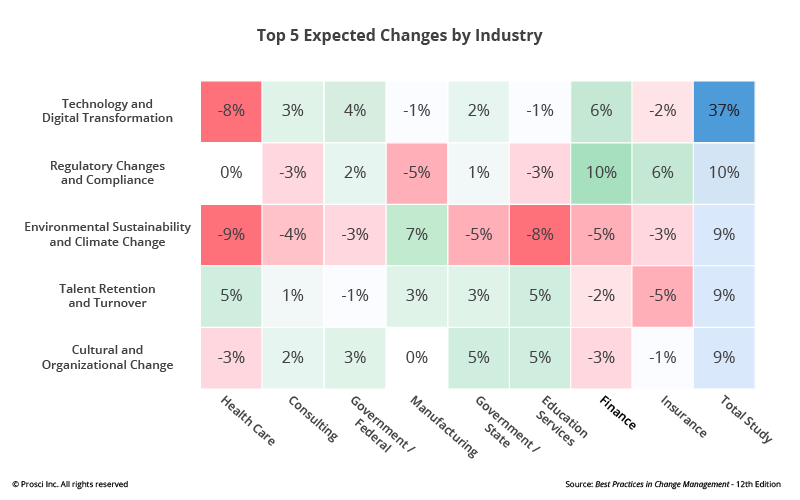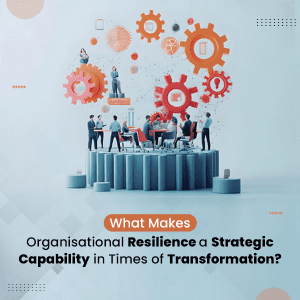
Key trends in 2024 are reshaping the way organizations manage change. From AI technology and digital transformation to regulatory compliance and talent retention, today’s trends will have significant impacts on your organization and people for years to come. As an organizational leader or change manager, understanding these trends and the supporting change management data empowers you to head off challenges and maximize the opportunities ahead. Let’s explore each trend to uncover the potential impacts on your organization, your people, and the evolving practice of change management.
What Are the Top Expected Organizational Changes in 2024 and Beyond?
During our Best Practices in Change Management – 12th Edition research, we asked participants about the biggest changes their organizations expected on the horizon. These are the top-ranked responses they shared:
- Technology and digital transformation (37%)
- Regulatory changes and compliance (9%)
- Environmental sustainability and climate change (9%)
- Talent retention and turnover (9%)
- Cultural and organizational change (9%)
When you take a closer look and separate these responses by industry, you see that certain expected changes will have far more significant impacts in some industries than others.

Although our Best Practices in Change Management – 12th Edition research covers the 12 top changes reported by participants, the largest responses are concentrated in the top five above. If the purpose of change management is to prepare, equip and support people on a successful change journey, these are the changes you will likely be helping them adopt in the next five years. You need to be thinking about and planning ahead for these, so that you can position your people, your projects and your organizations to succeed as the discipline of change management continues to evolve.
1. Technology and digital transformation
Examples of changes cited in the research include automation, training, user adoption, leadership, integration and automation, governance, change management, systems consolidation, culture, data strategy—and of course, artificial intelligence (AI) technology. More on AI below
2. Regulatory changes and compliance
Example changes include those related to security, government, data privacy and security, AI, perception, communication, continual change, culture and funding.
3. Environmental sustainability and climate change
Example changes include recycling, emissions reduction, transportation commitment to sustainability, communication, carbon tax, awareness, packaging, reducing travel, and regulations.
4. Talent retention and turnover
Example changes include those related to compensation, remote work, development pathways, leadership development, qualification, work-life balance, training, resources, culture for retention, burnout.
5. Cultural and organizational change
Example changes include those related to leadership, trust, communication, transparency, behavior, connection, understanding, merger and acquisition support, and ego.

Artificial Intelligence and Change Management
Let’s take a moment to dig deeper into AI technology because it is causing significant disruptions to seemingly everything, and the change management discipline is no exception. The way we manage change will never be the same.
Our team at Prosci has been thinking about AI a lot lately, both through practical application in the workplace and establishing AI governance and standards at Prosci. As AI comes to fruition, there are really four dimensions of disruptive change to consider.
Industry disruption will fundamentally be disrupted based on the nature of the particular industry.
Organizational disruption will come in the form of projects, initiatives, strategies, departments, divisions and roles as organizations figure out how to bring AI into the way they do business.
There will be job disruption, where certain jobs will start to be replaced by automation. And a very small segment of jobs will be fully replaced.
And there is task disruption to consider, and that’s where it gets really interesting. What are you doing today that you can do better, faster, more effectively with a quicker first draft and a larger sample size? This is when you start to tap into the power of this new technology.
AI and change management webinar findings
In our recent interactive webinar, Preparing for the Future of Change Management With the Latest Trends, participants shared the degree to which they are using AI in their change management work. Many change managers are starting to dabble with AI to enhance their productivity (36% from webinar poll), while the rest are using it every day (22%), finding its use more common (23%) or waiting on the sidelines (18%).
The most common change management applications reported in the webinar are in communications, data analysis, training and development and task support.
- Communications – Planning, generating drafts, translating materials and messages, editing for clarity and conciseness, improving content, generating analogies to help explain concepts, documentation, scheduling messages, personalizing and tailoring communications, and writing support.
- Data analysis – Change management data collection, sentiment analysis, summarizing, deploying surveys, and synthesizing large datasets.
- Training and development – Planning, developing procedures, storytelling, creating materials and developing assets.
- Change management task support – Identifying areas of resistance, brainstorming ideas, planning, coordination, developing strategies, and conducting impact assessments.
Findings from AI and change management research study
The informal webinar findings above closely resemble those from our formal research study on AI and Change Management, which is available in Research Hub. When we asked research study participants how they are using AI tools and technologies in their change management practices, the top responses were:
- Communication support
- Content creation
- Strategy and planning
- Stakeholder engagement
- Data analysis
When we asked study participants what impact AI tools and technologies are having on their change management work, the top responses were:
- Increased efficiency
- Enhanced communication
- Accelerated problem solving
- Support in content creation
- Improved workload management
- Facilitates idea generation
- Limited impact
How to start using AI in your work
Change practitioners are feeling the pressure to incorporate AI tools into their work but struggle with getting started. After a lot of experimentation and application, I have learned a few basic tricks that may help you start generating content with ChatGPT—which I think of as my “AI intern.” Here’s a basic example:
Start by clearly defining the output you are going to create and putting the prompt into the chat tool:
We are going to write a proposal.
You can start with limited detail and add more as you go. The key it to align on the endgame—the output you’re looking for—and to create guardrails for your AI intern.
Add context by providing enriching details or encouraging some research.
We are creating a grant proposal on behalf of a nonprofit in McCall, Idaho called CIMBA at the website https://www.cimbarides.org.
Refine with additional prompts. It’s critical to remember that working with AI and achieving good results requires iteration and scrutiny. In reality, you’re not a prompt engineer—you’re a prompts engineer.
Watch this webinar for more tips and tactics for collaborating with AI in your change management work.
Change Management Trends and Discipline Changes
No one can predict the future, but our research offers predictive insights. Analyzing and synthesizing the change management data in Prosci’s Best Practices in Change Management – 12th Edition research study revealed the following top trends in change management for the next five years:
- More emphasis on the human side of change
- Alignment of change management to the strategy and culture of the organization
- Adoption of Agile change management practices
- Increased awareness and understanding of the importance of change management
- Use of technology to support change management (including data analytics and AI)
- Building change management capability and capacity within organizations
- Increased integration of change management with project management
6 meta trends in the change management data
Prosci has been conducting best practices research for more than 25 years, and we started conducting specific research on change management trends in 2013. Interestingly, when we analyzed Prosci’s change management data over time (from 2013 to 2023), we identified six meta trends:
Converging people, culture and strategy
In 2019, the notion of integrating people-side impacts into organizational culture—the intersection of culture and change—hit the radar, and then the COVID-19 pandemic happened and amplified the convergence of people, culture and strategy. Watching leaders, change practitioners, organizations and disciplines bring these pieces together is promising in terms of where you can start to lead your organization going forward. As a discipline, we see this in the number of projects applying change management, DEI initiatives, development, social impact work, and especially in leaders stepping into their roles as sponsors during change and showing up to guide organizations in a new way.
Adopting Agile
We saw Agile hit the top of our change management trends list in 2019. Prosci conducted a dedicated research study in 2018 on the intersection of agile and change management—how to bring them together in a more iterative and adaptive approach to change. It’s been interesting over the last four years to watch the dogmatic nature of Agile methodologies evolve as the pandemic made all change iterative and adaptive out of necessity. We’re seeing evidence of this in technology projects and initiatives, as well as adopting more flexibility and agility in the ways we work.
Increasing awareness of the need for change management
This trend has remained in the middle of the list across all of the studies where we asked about change management trends. Increasing awareness of the need for change management is something we have always been up against as a discipline. We do still need to make the case for the need for change management, but times are changing. Back when I joined Prosci, change management was unknown or thought of as communications and training. It’s really a holistic approach to helping our individuals who are living within the organization experience successful change and change journeys.
Then there’s been an interesting renaissance over the last decade where everyone needed change management, even though they had no idea what it was. If there was a problem on a project, they’d call in change management to solve it. But there was no understanding of why it was valuable. Today, things have improved, but we need to show tangible benefits through change management data analysis, help people explore the consequences of ignoring the people side of change, and demonstrate its impacts on the organization’s bottom line.
Leveraging technology
We touched on this above when we explored AI and change management. Certainly, technologies around communication and collaboration are going to be huge part of it. When supporting and connecting people in organizational changes Management, we’re seeing collaboration platforms like Microsoft Teams and tools like virtual whiteboards continue to bridge gaps.
Although we have virtual work and in-person work figured out, the hybrid workplace challenge will require more attention from change practitioners who need to understand how to best leverage technology and tools for their unique organizations and changes. I see hybrid work as continuing to be one of the most significant change management trends today.
Building organizational change capability
Building change capability has been a trend in our research since 2013. Applying change management on an initiative is fine, but building change management capability as an organizational competency is where real organizational transformations—and competitive advantages—come to life because change management becomes part of your organization’s DNA. The biggest impacts on building change capability we’re seeing come from increased application across the enterprise, sponsor activities, clear goals, sponsor messaging, and lessons learned from failed projects. Increased application was another big piece of building organizational capability.
Integrating change management and project management
This trend of integrating change management and project management peaked in 2015. Integrating project management and change management is still important, but it’s at the bottom of the list of change management trends we need to focus on because it’s almost become an expectation. The technical side of the change is executed by project management and the people side of change is executed by change management, and they work together to achieve a common objective of successful outcomes. The two disciplines are inextricably linked to how change comes to life in the organization.
Change Management Trends and Data
Change management is a crucial aspect of any organization’s success and it is constantly evolving. In 2024 and beyond, it is evident that organizations will continue to face challenges in managing change, whether in adopting new technology like generative AI or responding to global events. From preparing and equipping employees for digital transformations to creating a positive workplace culture around change, organizations must proactively embrace these expected changes and trends to succeed in tomorrow’s world.






